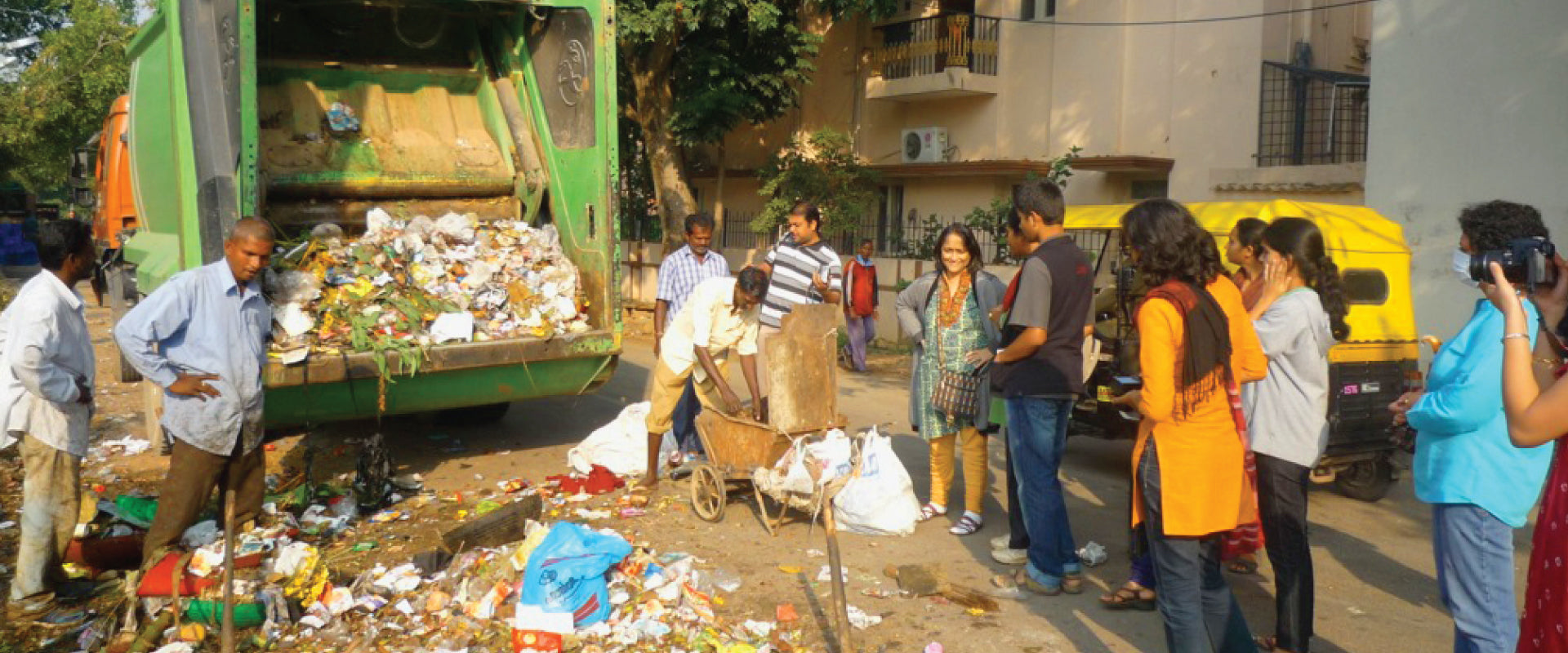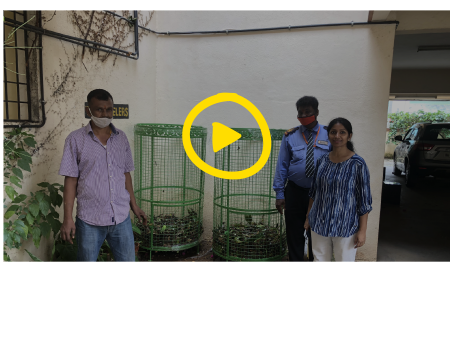From Symbol to Jugaad to Product

We are at the verge of launching our new product at Daily Dump – yes, another home composter. This composter marks one more notch on the exploratory journey that began in 2006. Our aim was to seed a new social norm, and to do this, we built several products in succession. This is the story behind them.
As the chief designer I am often asked how I make the design decisions I do – like creating a metal lid for our terracotta composters from a traditional “balti” used in the construction industry; and a composter out of a ubiquitous wheely bin.
While eventually my values, beliefs, motivations have shaped the forms and content I have created, my environment and my fears have also impacted the final outcomes.
I see myself having been influenced in three different ways:
- The right time and the right place.
- The burden of being middle class
- Design for Idea Adoption.
Being in the right time and place.
My personal journey with product design has been coincidentally in sync with the evolution of the field of Product Design as a whole - towards Design for Sustainability (DfS); & Design for Systems Innovations and Transitions. Daily Dump’s products are born out of this juxtaposition.
Industrial design has its own history of self-reflection and soul searching. As a student I remember heated discussions round the contradictions inherent in industrial “forming” and ecological regeneration. As product designers we were cast as abettors of mindless consumerism and not as agents to catalyze positive change. Victor Papanek, Buckminster Fuller and Gandhi helped us find more meaningful definitions for ourselves.
Viewing the effects of our discipline with a critical eye – we saw what Papanek meant when he said, “much of what was manufactured was inconvenient, often frivolous and even unsafe”. We were living in the time of the emergence of the idea of that there was a “real” world which Design was not serving. Green Design was a nascent term; it was ahead of its time then. We were eager to use apply these new ideas of product design, but the world was not ready for need this in the 1980s.
Then in the 90’s India with the economic rules changing we saw businesses gravitate to design and by the late 90’s designers were confidently cementing the idea that Design is good for Business. I had the opportunity to explore the ideas of eco-design (green design had graduated) and observe how different communities and peers engaged with these as I was creating curriculum for the new design school in Bangalore (Srishti) and interacting with practitioners and scholars in these areas.

I set up opportunities to explore the different facets for our Indian context and my students did many projects around the ideas of eco-design, user-centered design, human-centered design, and social design. Composting for urban homes was one such project and it happened at the later part of my teaching stint. It coincided with the urge in me to put into action all the ideas I had deeply engaged with in my role as a teacher and which were also an extension of my inquiry in college.

The conversations as a student, my experiences as a teacher, and the early work I had begun doing - all these contributed to implementing at Daily Dump the preference for Systems Thinking, nudging behaviour changes over time by creating pathways.
And Bangalore in 2006 was just the right crucible for a Daily Dump kind of venture to begin. (It is interesting that other waste ventures in the city were also forming at that time)
- The burden of being middle class
I get very impressed with the energy and achievements of the young startup founders of today. I love their ability to have a viable plan in place and move on to the next big thing. It demonstrates a competence and appetite for risk. There is a method in their approach, and it is now normalized through the eco-system that supports and incubates entrepreneurs.
When I began Daily Dump it never occurred to be that I could go and get money – I put this down to my middle class conditioning. I had not learnt enough about money; I was not comfortable asking for money and for the longest time I was under the impression that all money taken from investors had to be returned (I mean how could it not?)
In hindsight not knowing about money was both a blessing and a burden. Not knowing allowed me to start something very risky but very fulfilling and I would not trade that for anything. Not knowing meant I took decisions that stemmed from a preference for frugality and that helped because it led to a laser sharp focus on costs, and ensuring we were viable in the market. Not taking money from investors in the first 6 years allowed me the focused time to concentrate on shaping the idea and growing the product service and educational aspects needed to get the first 2000 customers.
Also, in 2006 I had enough of working with others, there was a simmering need to put the thoughts in my head into action and a conviction that even if it failed, I had to try. I wanted a lean setup with the least compliance regulations competing for my limited attention. So, I began as a proprietorship and worked out of my basement very content with every new customer and without a goal or any plan to measure my progress against - again my middle-class value of “be content” kicking in or me enjoying the journey.

But not knowing enough about money left the company without the necessary capital to scale.
And now in 2022, it has got a new co-founder and CEO who comes without my shortcomings and will work to scale the company.
I still don’t understand money, but I am told that I belong to the majority out there.
Design for Idea Adoption
People see our products – but we did not set out to make things. We set out to change perception and plant an idea that composting at home was important, fun and the future lifestyle. An idea that individual choices do impact the larger world in many ways.
It was my bias for the principles of systems change that shaped my choice of an open-source path for the first range of products. I wanted to catalyse the adoption of this new practice, not just sell products. The idea of composting was more important to spread, the product was primarily the vehicle to transition one behavior into a climate friendly one. This was not a business led decision or even a pure product design decision.
Composting is a natural process – Evolution has perfected the process over millennia. My question was - What do I need to do to make it a part of everyone's behavior? (in India, in Bangalore to start with- not the world) If I can achieve this being mindful of the whole system that waste in India is located in - then what should the design be - of the product? Everyone I spoke to, said it would not stick, no Indian would be willing to do this, it was a dirty process.

Also, terracotta after my initial tests with materials - was the best material to support the decomposition process. Plastic didn't breathe. Because terracotta had no perceived value, was heavy and fragile I had to design around our "convenience" hang-up. - Design had to build value in the face of these factors. The beauty of the material and the hand crafted form helped take composting away from the “yuck” backyard space to the “cool” garden space.
Our customers again and again showed us that they preferred this “heavy” “fragile” product over the plastic DIY versions, only because they could see a value even though they found it hard to articulate the reasons. I suspect that reasons are to do with a part of us that respects the labour of the hand, the connections between natural cycles and the magic of composting happening in the bowels of a mud pot.

So I began with a product that did not look dirty, was good looking but was also ordinary, so unthreatening that it would seem like nothing at all. I wanted to create something that was so “ordinary” that it would fly under the radar of the grandmasters of waste - the municipality, contractors, experts and naysayers. It would not be perceived as a threat, so it had greater chances of being adopted without being snuffed out pre-maturely by some large technological promise or a “mercenary” business imperative.
I wanted a symbol. A symbol that could catalyze action and help spread the idea. I had to make the barriers for replication low because that was the design intention – to have many people grow the movement. To allow others to own and copy and feel that it was their badge of pride to do so.

As we grew the perceived value of the practice, we discovered this is a hard market, folks are not lining up to buy composters and composting accessories, the plethora of DIY options erodes the market size. In this context it was foolish to invest in high capital production options – Jugaad was the only answer, so we mixed and matched and hacked our way into a series of products.
No designer likes to think of themselves as a Jugadu! I am comfortable not being a purist because after all this Jugaad helped monetize an externality and reduce the harm to the environment. For every Jugaad design I did I was mindful of the materials and keeping the overall environmental impacts low. Jugaad prototypes in our case do create value.

Open Source and Jugaad does not build defensibility like my MBA friends tell me, but they do aid replicability and help create a new norm in the most cost-effective way.
Over the last 16 years, we have seen our products impact our customers’ behaviours and hopefully their lives, as also the Earth itself. We have led the development of this market and energized the idea that decentralized systems are as important as centralized ones in our efforts to build better environments.
Now having stayed the course with the “Age of Adoption” we are ready to launch a product. A product that by business standards has defensibility and also meets the standards of Dieter Rams golden 10 rules of product design. And latest home composter Terrabite does well on these rules -
- Good design is innovative
- Good design makes a product useful
- Good design is aesthetic
- Good design makes a product understandable
- Good design is unobtrusive
- Good design is honest
- Good design is long-lasting
- Good design is thorough down to the last detail
- Good design is environmentally-friendly
- Good design is as little design as possible
From Symbol to Jugaad to Product - having stayed the course these 16 years we have grown the market appetite for a more sophisticated product – that is very convenient to use, fits into our urban landscapes and can be shipped easily across the world. (A patent is on the cards)
Welcome to Terrabite (the ultimate home composter) Fill it Flaunt it.

If you are in Bangalore on the 20th of August 2022 – do come for the launch at 10:30 am at our Experience Center.
Want to buy one for your home or for the buildings you are making?
Do write to me at hello@dailydump.org if you want more details.
Poonam Bir Kasturi




